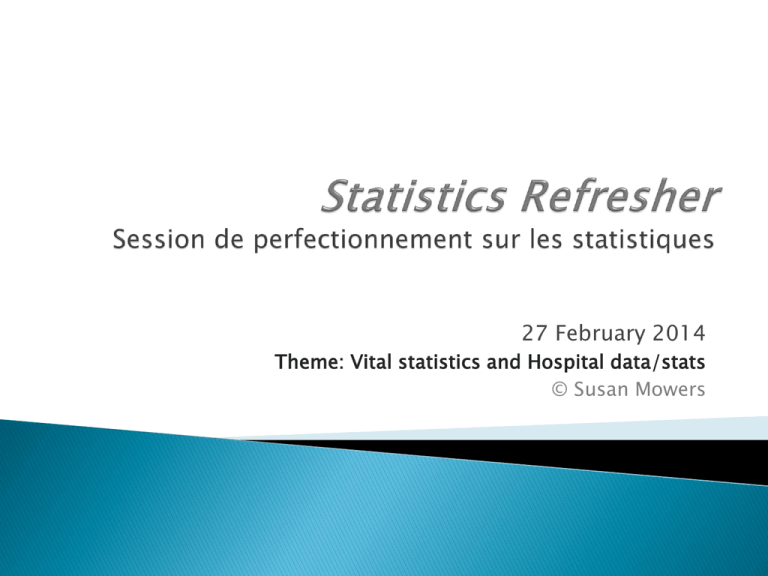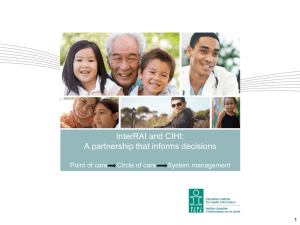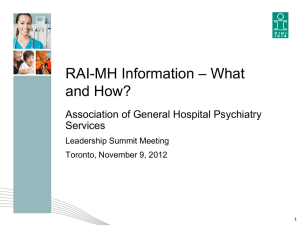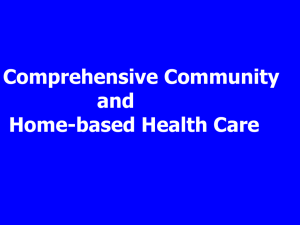
27 February 2014
Theme: Vital statistics and Hospital data/stats
© Susan Mowers
Introduction to, and opportunity to practice using,
typical sources for vital statistics and hospital
statistics;
to recognize the major sources of data “behind”
these statistics, together with their advantages and
disadvantages.
Data and statistics, what are they?
What are the major sources of health data?
What are vital statistics and why are they
important? Where can I find them?
What is hospital data and why is it important?
Where can I find them?
Similarités, Différences?
Technical?
Audience?
Data?
Statistics?
Why statistics?
Data can provide a context, paint a
picture, support your
argument/questions…
Why data?
Research methodology where a
research hypothesis is refuted or
proved by analysing/using data
- defining your research concepts
ex., maladies, comportements, population ciblée,
facteurs sociaux ou environnementaux
- situating your subject
ex. dans le temps et dans l’espace
- adding weight or meaning to your argument or
research question
Audience?
Quantitative researchers (having
statistical knowledge - usually)
ex. maladie associée à une espérance de vie plus courte
Data sources are identified at
research proposal stage
New applications for nonstatisticians: Data tabulation or
visualisation services
Data
Every one
Audience limitations are a function of comfort level and numeric
literacy – e.g., professors unfamiliar with statistics
Support considerations:
Audience?
Support considerations:
Some calculations and manipulations
may be required before the statistics
can be used.
Statistics?
For …
Data « Analysis »
Descriptive information
Use …
Microdata (e.g., from
censuses and surveys)
Aggregated data, (e.g.,
from censuses, surveys,
vital statistics,
administrative data)
“Secondary data” are gathered by
statistical agencies (censuses
and surveys), hospitals,
community health services
(administrative data), provincial
governments (vital statistics) and
so on
OVERVIEW and CONCEPTS
Let’s start with the National Library of Medicine’s list link
Note: these groupings are a little different than ours
Administrative data and registers
Population survey data
Primary data
Secondary data
Let’s work through pages 1 and 2 of
the handout
Cradle to Grave
Statistique de l'état civil
Statistiques de vie
“Cradle” to “Grave”
Life-giving or taking type events
Include: births, marriages, divorces, abortions,
deaths and fertility rates, and can be used in
various calculations, e.g., population density, life
expectancy rates, population estimates
Definitions link
Births
Age, marital status and birth place of parents
Place of residence and parity of mother
Live births, still births, miscarriages
Type of birth (single or multiple)
Gestational age, sex and weight of infant
Date and place
Completed by parents AND often also reported by
health professionals. Filed with municipal birth registry.
Summary tables on CANSIM, link | metadata link
Publication “Births” link |
Other
Abortions
Marriages
Divorces
Deaths
Glossary Link
Age, sex, marital status, place of residence and
birthplace of deceased
Cause, manner, province/territory and date of death
(Aboriginal status)
Tracked by PROVINCIAL CHIEF CORONERS and MEDICAL
EXAMINERS OFFICES
Statistics canada: link 1
Hint: Go to province for more details on place of death)
– good overview tables link. Summary tables on
Summary tables on CANSIM: Deaths link (metadata)|
Stillbirths link (metadata)
Publication: Deaths link … Nationally: 1921-
Use CANSIM:
http://www5.statcan.gc.ca/cansim/a01?lang=eng
Choose one …
Find: Which province or territory had the lowest teenage suicide rate in
2011?
Select Population and demography Births and deaths Deaths and mortality rate, by selected grouped
causes and sex, Canada, provinces and territories, Table 102-0552 (screen 2)
Find: Which province has the highest fertility rate in 2000, and in 2011?
How does this differ for the territories?
As above … Crude birth rate, age-specific and total fertility rates (live births), Canada, provinces and
territories, annual (Rate), 2000 to 2011, Table 102-4505 (screen 2)
Do: Make a bar graph in Beyond 20/20 of Quebec’s total fertility rate per
1,000 females from 2000 to 2011
Use Table 102-4505 as above
(normally we’d create a line graph for trends over time, more
about graphs)
Provincial government annual reports are an
“vital” source of vital statistics
If they don’t provide answers, contact the
agency.
Health Profile, link and Health Indicators, link
◦ Cover data from the Canadian Community Health Survey,
CIHI, Canadian Cancer Registry, and Vital Statistics.
◦ The former (Health Profile) allows comparison of health
indicators for two regions at a time, while the later (Health
Indicators) provides access to health indicators from all
regions in Canada.
See handout for various changes regarding the
collection and distribution of vital statistics.
These changes affect marriage, divorce and
abortion vital statistics. Statistics Canada’s
mandate for collecting vital statistics has been
considerably reduced.
And what did you catch at
your hospital lately?
Hospitals report all admissions (100%)
◦ Reporting procedures:
for out-patients, day surgery, ED visits … both hospital-based and community-based
ambulatory care
(Core database: National Ambulatory Care Reporting System (NACRS))
for acute-care, mostly in-patients
(Core database: Discharge Abstracts Database, or DAD, which populates other databases like
the Ontario Trauma Registry,, Hospital Mental Health Database),
Quebec and British Columbia have their own acute care databases
◦ Covering, for example,
◦
Administrative and related information:
time of admission (also admission data like admission via ambulance, demographics, health care
number …
time of discharge/death/sign-out or transfer (therefore, length of stay)
Diagnosis information, ICD classification (multiple records)
Intervention/treatment episodes (multiple records)
Provider information including specialties, and more
For patients with specific conditions, such as cancer or MS, additional information may be required
(100% registries by disease/condition)
CIHI’s overview of their data holdings, link
◦ Tables in reports like Hospital Trends in Canada link or Hospital Report Series
link(found on the CIHI online “store”) link
◦ We’ve seen Health Profile, link and Health Indicators, link from Statistics
Canada for coverage of the health regions
◦ Let’s look at Quick Stats link for topic Hospital care, e.g., DAD/HMDB Newborns
Born in Hospital (by sex). We can change topic to Specialized Care or to
Spending for more hospital data. Can you find other topics that cover hospital
data?
In addition, View a short Quick Stats video on how to understand and use these
reports.
◦ CIHI’s Health Indicators Interactive Tool, link
◦ Respondent information on hospital treatment via
the Canadian Community Health Survey (together
with extensive health determinant and health status
data) … also gives health region
◦ ICES scientists, some data linkages possible
◦ Link to Census neighbourhood data with postal
code conversion files.
Canadian Organ Replacement Register
◦
Organ transplants, organ donation and end-stage renal disease (ESRD) in Canada.
e.g., Canadian Organ Replacement Register Annual Report: Treatment of End-Stage Organ Failure in Canada
◦
Reference question: Prévalence, incidence (bref, épidémiologie) de l’insuffisance rénale chronique (chronic kidney
failure) au Canada et en Ontario, mais aussi aux ÉU et ailleurs dans le monde – nombre de cas, ou % de la population
présentant cette pathologie.
◦
See link to portal
Canadian Joint Replacement Registry
◦
◦
Reference question: Where can I find the number of hip and knee replacements performed in Ontario and in Canada?
◦
See link to portal
Canadian Multiple Sclerosis Monitoring System
◦
◦
Why the registry? Joint replacement is one of five priority areas targeted for shorter wait times in Canada.
Canada is estimated to have one of the highest MS rates in the world. Since September 2012, the CMSMS has
been ready to receive data.
see link to portal
National and Ontario trauma registries
◦
The national registry will close on March 31, 2014. In future data from Discharge Abstract Database (DAD) and Hospital
◦
This change will not affect the Ontario Trauma Registry (OTR), which is operated by CIHI and funded by the Ontario Ministry
of Health and Long-Term Care. The OTR will continue to collect and report on injuries in Ontario.
◦
Morbidity Database (HMDB). You can access data, including the historical NTR Comprehensive Data Set (NTR CDS), through our data
request process.
See link to portal
Use sources:
Slide 20 and 22 …
Choose one …
Find: Where can I find hospital admission rates for births?
Find: Where can I find the number of hip and knee replacements
performed in Ontario and in Canada?
Fundamental to academic research
(e.g., allow many original inquiries)
Researchers use survey data to analyse
society, the economy, and more…
Some social topics
◦ demographics, ethnicity, family structure,
work life, health-related behaviours, values,
chronic diseases, treatments, sleep,
neighbourhood, housing, time-use …
Surveys are multi-topical
Data collection
◦ WHO PAID?
◦ WHO COLLECTED?
◦ WHY?
◦ Political agenda/bias?
◦ Reputation for survey methodology and
statistical analysis?
Methodological documentation and data
definitions are ESSENTIAL for evalulating data
Discharge Abstract Database: “Geographic” and “Clinical”
◦ public use microdata files :
Access: https://login.proxy.bib.uottawa.ca/login?url=http://odesi.scholarsportal.info/documentation/dad/dadlicense-en.html
presentation: http://cudo.carleton.ca/dli-training/2669 |
webinar (31 mins): https://gts-ee.webex.com/gts-ee/ldr.php?AT=pb&SP=MC&rID=33111&rKey=c0198b19ffef2685
Note: The WebEx ARF player is required to playback the recording. Download ARF player
ICES data holdings
https://datadictionary.ices.on.ca/Applications/DataDictionary/Default.as
px
Graduate students’ (customized) CIHI data requests
see presentation above, slides 27◦ http://www.cihi.ca/CIHI-extportal/internet/EN/TabbedContent/standards+and+data+submission/data+requests/cihi0
12210
UN/WHO: Global Health Observatory data
repository
http://apps.who.int/gho/data/node.main.A1626?lang=en
OECD.stat
https://login.proxy.bib.uottawa.ca/login?url=http://stats.oecd.org/
WBOS/index.aspx
OECD iLibrary link
E.g., acute renal failure link
2013 Health at a Glance link
ONU, Objectifs du millénaire pour le
développement et l’après-2014,
http://www.un.org/fr/millenniumgoals/gender.shtml
les 8 Objectifs du Millénaire pour le Développement (OMD)
http://www.statcan.gc.ca/dli-idd/dli-iddeng.htm
Was a major breakthrough in data access and
changed data culture
-
ALL public microdata files, detailed statistics,
e.g., DA level, geographic files and all
related documentation are free
-
Restrictions on Use:
- Our users only, more restrictions on CIHI DADs
and postal code products. Otherwise users have to
sign their own licenses (product by product)
Interpreting data via Statistics Canada and CIHI.
DLI contacts are on top of range of public data sources
(including metadata) from Statistics Canada and CIHI
New data sources and services being added, many
being published to Odesi supervised by DLI contacts
and Scholars Portal
COOL RDC has the confidential files from Statistics
Canada, like the CCHS








